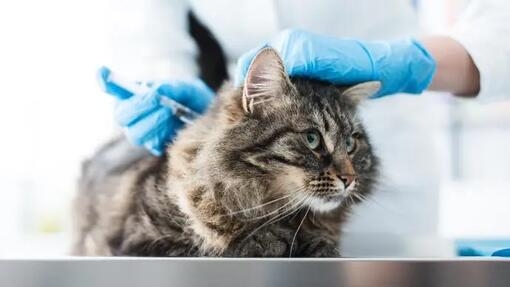

It can be devastating for your feline to be diagnosed with cat skin cancer, but many types if caught early enough are very treatable. Tumours can be benign which means they’re usually not harmful, or malignant, meaning they can be fast growing and harmful. Either way, if you discover a lump or bump, it’s best to have it checked out by your vet as it could be cat skin cancer.
Learn what causes skin cancers in cats, what to look out for and the current treatment options available.
What causes cat skin cancer?
The most common cause of skin cancer in cats is sun exposure. This is particularly true of lighter cats with white fur, a thinner coated or even hairless felines such as the Sphynx which are prone to sunburn. There’s also been some evidence of a link between compulsive licking and skin cancer as this causes skin damage, putting cats at an increased risk. Additionally, some types of skin cancers are genetic.
Types of cat skin cancer
There are three main types of skin cancer in cats which are as follows:
Malignant melanoma
Malignant melanomas in cats develop in the skin’s pigment-producing cells and are usually found in areas of mucous membranes such as the mouth and nose. However, in rare cases, it can develop on the skin. This type of skin cancer tends to be fast spreading and can quickly spread to the lymph nodes and organs. It’s thought that this type is genetic.
Squamous cell carcinoma
Squamous cell carcinoma in cats is related to sun exposure and will usually first present as ‘solar dermatitis’, which are crusty, red areas, most often seen on the tips of their ears, eyelids and nose. The scabbing may come and go and if left, it can become cancerous. Luckily, this type tends to be slow spreading and doesn’t tend to spread at all until the later stages.
White felines are much more likely to develop squamous cell carcinoma as their skin is more vulnerable to UV light.
Mast cell tumours
Mast cell tumours are located in the mast cells of your cat’s immune system and will display as an under-the-skin lump, usually located on their head or neck. There’s a number of things that can cause this type of skin cancer including genetics, inflammation and irritation. Additionally, Siamese cats tend to be more at risk.
Symptoms of cat skin cancer
The symptoms of skin cancer in cats will depend on the type, but there are a few general signs you should be on the lookout for:
- Scabbing, particularly on the ears, nose or eyelids.
- Black, crusty patches of skin.
- Weeping, raw skin.
- Red and raised areas of skin.
- Wounds that won’t heal.
- Ulcers.
- General lethargy.
In terms of squamous cell carcinomas, skin symptoms may worsen over the summer months and improve during the winter.
It’s a good idea to regularly groom your cat and closely examine their skin so you can check for any lumps, bumps or wounds. If you spot anything unusual, it’s important you get it checked by your vet right away as early intervention is key in giving your cat the best possible shot at recovery.
Cat skin cancer diagnosis
Diagnosis of cat skin cancer is often done via needle aspiration; this involves cells being taken with a fine needle for examination underneath a microscope to analyse if they’re cancerous. A surgical biopsy may be required to confirm cancer, this involves removing tissue for examination, your cat will need to be sedated for this. Other tests may be carried out including a fluid sample from the lymph nodes and X-rays.
Cat skin cancer treatment
Surgery is often required in order to remove the tumour in question. If it affects the ears, these may need to be removed (this procedure is called a pinnectomy), but don’t worry, this won’t result in hearing loss! Chemotherapy may be recommended, but this will depend on the stage of the cancer. If the cancer can’t be removed, radiation or cryotherapy (where extreme cold is used to freeze and kill cancerous cells) may be recommended.
The only complete cure for skin cancer is the removal of the whole tumour, and even then, there’s a risk it could regrow.
Cat skin cancer prevention
With inherited or genetic cancers, unfortunately there’s nothing you can do to prevent it apart from avoiding breeding with cats that are prone to these skin cancers.
But for those that are caused by sun exposure, there are a few things you can do. If your cat has any pink patches of skin, apply a waterproof, pet-friendly sunblock (over factor 30), each day. For hairless and light-furred cats, it’s a good idea to keep them inside when it’s warmer, especially during the middle of the day when the sun is at its most damaging.
Want to find out more about the cancers that affect cats? Read our guide on lymphomas in cats, next.
Recommended by Pro Plan:
Related articles










